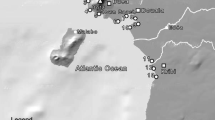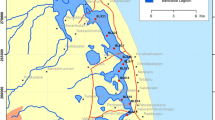Abstract
Tsunami sediments deposited in a coastal zone of Thailand by the 26 December 2004 tsunami wave were sampled within 50 days after the event. All surface and ground waters in tsunami- inundated zone revealed significant salinity at that time. The tsunami sediments, composed mainly of fine to medium sand, contain significantly elevated contents of salts (Na+, K+, Ca+2, Mg+2, Cl and SO −24 ) in water-soluble fraction, and of Cd, Cu, Zn, Pb in the bioavailable fraction and As in the exchangeable fraction in relation to the reference sample. The origin of contaminants is marine, as well as litho- and anthropogenic. The salts and Pb, Zn and Cu reveal high correlation to each other and to the mean grain size (pore size and porosity). Serious environmental hazard exists in that region because, due to gentle morphology, there is a risk of migration of the contaminants into ground waters and food chain.



Similar content being viewed by others
References
Blott SJ, Pye K (2001) Gradistat: a grain size distribution and statistics package for the analysis of unconsolidated sediments. Earth Surf Process Landforms 26:1237–1248
Bryant E (2001) Tsunami. The underrated hazard. Cambridge University Press, Cambridge
Bryant E, Young R, Price D (1996) Tsunami as a major control of coastal evolution, southeastern Australia. J Coastal Res 12:831–840
Chagué-Goff C, Goff JR (1999) Geochemical and sedimentological signature of catastrophic saltwater inundations (tsunami), New Zealand. Quat Aust 17:38–48
Dawson AG (1994) Geomorphological effects of tsunami run-up and backwash. Geomorphology 10:83–94
Dawson A, Shi S (2000) Tsunami deposits. Pure Appl Geophys 157:875–897
Dawson AG, Shi S, Dawson S, Takahashi T, Shuto N (1996) Coastal sedimentation associated with the June 2nd and 3rd 1994 tsunami in Rajegwesi, Java. Quat Sci Rev 15:901–912
Folk RL, Ward WC (1957) Brazos river bar: a study in the significance of grain size parameters. J Sediment Petrol 27:3–26
Gelfenbaum G, Jaffe B (2003) Erosion and sedimentation from the 17 July, 1998 Papua New Guinea tsunami. Pure Appl Geophys 160:1969–1999
Goff J, Chagué-Goff C (1999) A late Holocene record of environmental changes from coastal wetlands, Abel Tasman National Park, New Zealand. Quat Int 56:39–51
Goff J, Chagué-Goff C, Nichol S (2001) Palaeotsunami deposits: a New Zealand perspective. Sediment Geol 143:1–6
Greenberg AE, Clesceri LS, Eaton AD (eds) (1992) Standard methods for the examination of water and wastewater, 18th edn. American Public Health Association, Washington, DC
Minoura K, Nakaya S, Uchida M (1994) Tsunami deposits in a lacustrine sequence of the Sanriku coast, Northeast Japan. Sediment Geol 89:25–31
Nanayama F, Shigeno K, Satake K, Shimokaka K, Koitabashi S, Miyasaka S, Ishii M (2000) Sedimentary differences between the 1993 Hokkaido-nansei-oki tsunami and the 1959 Miyakojima typhoon at Taisei, southwestern Hokkaido, northern Japan. Sediment Geol 135:255–264
Nishimura Y, Miyaji N (1995) Tsunami deposits from the 1993 Southwest Hokkaido Earthquake and the 1640 Hokkaido Komagatake Eruption, Northern Japan. Pure Appl Geophys 144:719–733
Orero Iserte L, Roig-Navarro AF, Hernandez F (2004) Simultaneous determination of arsenic and selenium species in phosphoric acid extracts of sediment samples by HPLC-ICP-MS. Anal Chim Acta 527:97–104
Riley JP, Chester R (1983) Chemical oceanography, vol 8. Academic, Orlando, FL
Riley JP, Skirrow G (1975) Chemical oceanography, vol 1. Academic, Orlando, FL
Scheffers A, Kelletat D (2003) Sedimentologic and geomorphologic tsunami imprints worldwide—a review. Earth Sci Rev 63:83–92
Shi S, Dawson AG, Smith DE (1995) Coastal sedimentation associated with the December 12th, 1992 Tsunami in Flores, Indonesia. Pure Appl Geophys 144:525–536
Williams M, Fordyce F, Paijitprapapon A, Charoenchaisri P (1996) Arsenic contamination in surface drainage and groundwater in part of the southeast Asian tin belt, Nakhon Si Thammarat Province, southern Thailand. Environ Geol 27:16–33
Acknowledgements
The field and laboratory work was supported by Adam Mickiewicz University in Poznań. Poland. We appreciate logistical support provided by Department of Mineral Resources of Kingdom of Thailand and Embassy of Poland in Thailand. We would like to thank Darunee Saisuttichai, Tinnakorn Tatong and Thawatchai Tepsuwan for field assistance and Radosław Jagodziński for laboratory work.
Author information
Authors and Affiliations
Corresponding author
Rights and permissions
About this article
Cite this article
Szczuciński, W., Niedzielski, P., Rachlewicz, G. et al. Contamination of tsunami sediments in a coastal zone inundated by the 26 December 2004 tsunami in Thailand. Environ Geol 49, 321–331 (2005). https://doi.org/10.1007/s00254-005-0094-z
Received:
Accepted:
Published:
Issue Date:
DOI: https://doi.org/10.1007/s00254-005-0094-z




